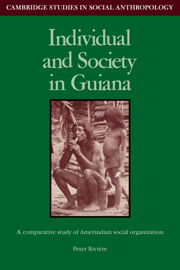Book contents
- Frontmatter
- Contents
- Acknowledgments
- 1 Peoples and approaches
- 2 The settlement pattern: size, duration, and distribution
- 3 Village composition
- 4 The categories of social classification
- 5 Aspects of social relationships
- 6 Autonomy and dependency
- 7 The individual in society
- 8 Guiana society and the wider context
- Notes
- Bibliography
- Index
- CAMBRIDGE STUDIES IN SOCIAL ANTHROPOLOGY
6 - Autonomy and dependency
Published online by Cambridge University Press: 01 October 2009
- Frontmatter
- Contents
- Acknowledgments
- 1 Peoples and approaches
- 2 The settlement pattern: size, duration, and distribution
- 3 Village composition
- 4 The categories of social classification
- 5 Aspects of social relationships
- 6 Autonomy and dependency
- 7 The individual in society
- 8 Guiana society and the wider context
- Notes
- Bibliography
- Index
- CAMBRIDGE STUDIES IN SOCIAL ANTHROPOLOGY
Summary
The focus so far has been on the settlement as an isolated, independent, and self-sufficient unit, and this approach is in accordance with the Amerindian's own view of the nature of the community. In Part I of this chapter this assumption is maintained while we look at the political relationships and processes internal to the settlement. This examination reveals that the actual size and stability of a settlement are to a large measure dependent on the relationships that constitute it. However, in Part II we have to face the fact that settlements are by no means the self-sustaining communities that native ideology proposes, and communication between settlements is vital for survival. The nature of the interaction and the mechanisms involved in their promotion are considered there.
It is safe to start from the position that the settlement is an autonomous unit. Although the relationship between settlements is the subject of the second part of the chapter, it may be said at the start that there is little evidence for the existence in the region within living memory of any form of supravillage organization. In the absence of any overarching, hierarchically ordered institution each settlement is master unto itself, and its internal political structure is safely studied in isolation.
The vital relationship is between the leader and his settlement. The two are intimately associated, and the latter depends for its existence on the survival of the former. This relationship often receives linguistic recognition: The settlement is referred to as a particular leader's place, or he is known as its founder or owner. At death his village is normally abandoned. However, it would be wrong to place too much emphasis on the settlement as either a geographical location or a physical entity.
- Type
- Chapter
- Information
- Individual and Society in GuianaA Comparative Study of Amerindian Social Organisation, pp. 72 - 86Publisher: Cambridge University PressPrint publication year: 1984



